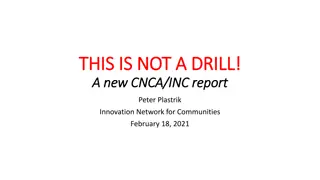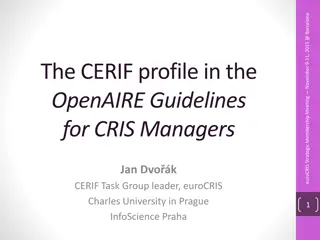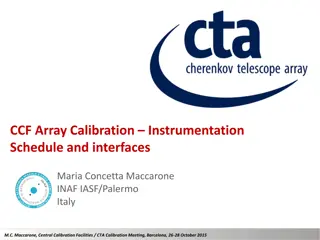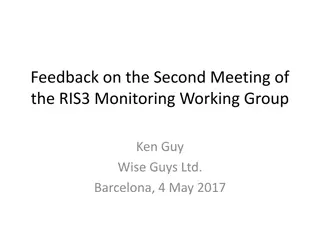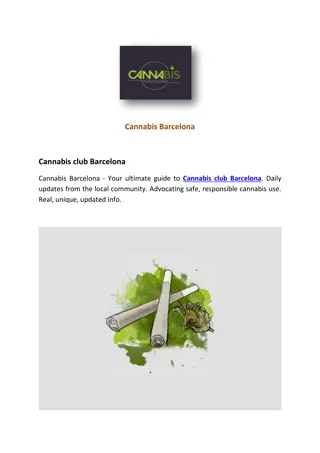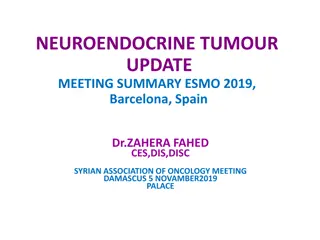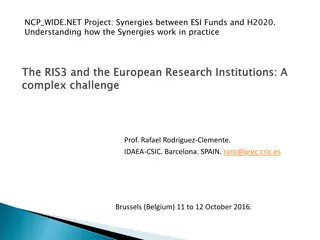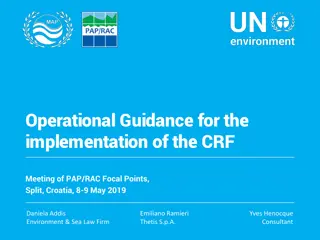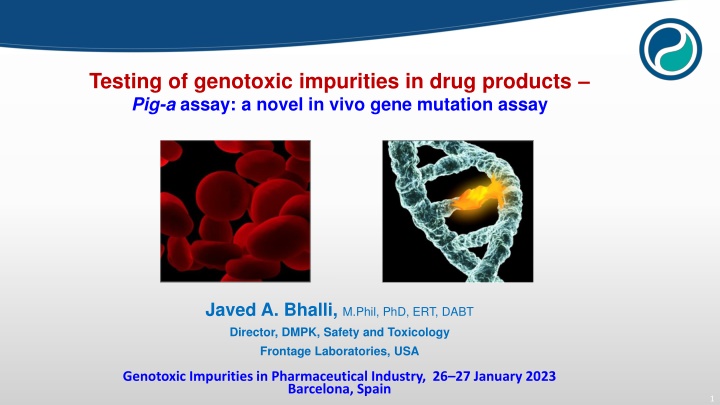
Genotoxic Impurities in Pharmaceutical Products
Explore the significance of genotoxic impurities in drug products through the Pig-a assay, a novel in vivo gene mutation test. Learn about the classification of impurities, sources, and guidelines for control actions. Discover the acceptable intake levels for individual and multiple impurities based on treatment durations.
Download Presentation

Please find below an Image/Link to download the presentation.
The content on the website is provided AS IS for your information and personal use only. It may not be sold, licensed, or shared on other websites without obtaining consent from the author. If you encounter any issues during the download, it is possible that the publisher has removed the file from their server.
You are allowed to download the files provided on this website for personal or commercial use, subject to the condition that they are used lawfully. All files are the property of their respective owners.
The content on the website is provided AS IS for your information and personal use only. It may not be sold, licensed, or shared on other websites without obtaining consent from the author.
E N D
Presentation Transcript
Testing of genotoxic impurities in drug products Pig-a assay: a novel in vivo gene mutation assay Javed A. Bhalli, M.Phil, PhD, ERT, DABT Director, DMPK, Safety and Toxicology Frontage Laboratories, USA Genotoxic Impurities in Pharmaceutical Industry, 26 27 January 2023 Barcelona, Spain 1
Impurities in Drug Products Impurities in Drug Products What is a Pharmaceutical Impurity Substances in pharmaceutical products that provide no therapeutic benefits but do have the potential to cause adverse effects Classification of Impurities Sources of Impurities Organic Manufacturing Processes Inorganic Degradation Residual Solvents Storage Condition Genotoxic Impurities Excipients Contamination 2
Impurities in Drug Substances Impurities in Drug Substances Series of ICH Guidelines on impurities ICH Q3A to Q3E - Impurities New Drug Substances, New Drug Products, Residual Solvents, Elemental Impurities, Biologics, 3
Impurities in Drug Substances Impurities in Drug Substances ICH M7(R1) Mutagenic Impurities Impurities Classification with respect to Mutagenic Potential and Control Actions Class Definition Proposed Action for Control 1 Known Mutagenic Carcinogen Control at or below compound acceptable limit 2 Known Mutagen with unknown carcinogenic potential (Ame positive, no Carcinogenicity data) Control at or below acceptable limits (appropriate TTC) 3 Alerting structure, unrelated to the structure of the drug substance; no mutagenicity data Control at or below acceptable limits (appropriate TTC) or conduct bacterial mutagenicity assay; If non-mutagenic = Class 5; If mutagenic = Class 2 4 Alerting structure, same alert in drug substance or compounds related to the drug substance (e.g., process intermediates) which have been tested and are non-mutagenic Treat as non-mutagenic impurity 5 No structural alerts, or alerting structure with sufficient data to demonstrate lack of mutagenicity or carcinogenicity Treat as non-mutagenic impurity 4
Impurities in Drug Substances Impurities in Drug Substances Acceptable intake for an individual impurity Treatment Duration 1 month >1-12 Months >1-10 Years >10 Years to lifetime Daily intake 120 g/day 20 g/day 10 g/day 1.5 g/day Acceptable intake for multiple impurities Treatment Duration 1 month >1-12 Months >1-10 Years >10 Years to lifetime Daily intake 120 g/day 60 g/day 30 g/day 5 g/day 5
Genotoxic Impurities Genotoxic Impurities Impurities that pose a significant safety risk, even at low concentrations, They may be mutagenic and are therefore potentially damaging to DNA. As a result, they can lead to mutations or cause cancer. Common in vitro Genotoxic Impurities Boronic Acids (Arylboronic acids and esters) 1-Ethyl-3-(3-dimethylaminopropyl)carbodiimide (EDAC) 2-Hydroxypyridine N-Oxide (HOPO) Nitrosamines 6
A new tool for testing in vivo Gene Mutation Pig-a Assay 7
Pig Pig- -a a Assay Assay Pig-a - Phosphatidylinositol glycan, class A gene Glycosyl Phosphatidyl Inositol (GPI) anchors found on the surface of various cell types, including RBCs, lymphocytes etc GPI anchors attach several proteins (e.g. CD59) to the cell surface Pig-a is the first in vivo gene mutation assay conducted in regular animals Score >100 millions RBCs in 2-3 minutes High throughput, Statistically robust Specific, sensitive, and reproducible Low sample requirement, repeat sampling from same animal(s) 3R Can be easily integrated into repeat dose General Toxicology studies 3R 8
Cell Surface Markers Cell Surface Markers CD59 Trans-membrane protein Trans-membrane protein Mutation in Pig-a gene CD24 GPI anchor Wild-type Mutant Phenotype RBC exterior Plasma membrane 9
Typical Experimental Designs Typical Experimental Designs Dosing: Days 1 28 Day: -1 1 15 29 Pig-a Pig-a Evaluate at least 108 RBC for mutant RBC freq. Evaluate at least 3 x 106 RET for mutant RET freq. 10
Methodology Methodology Majority towards magnetic column separation Add Anti- PE MicroBeads Small fraction towards Nucleic Acid Dye Solution with Counting Beads Analyzed for; Mutant RBC:Bead ratio Mutant RETs:Bead ratio Cells Plus Anti-PE MicroBeads Wild type cells labeled with Anti- CD59-PE Nucleic Acid dye staining and Counting Beads Spin step Concentrate d eluate and counting Beads Eluate highly depleted of wild- type cells Concentrate d eluate 11
Flow Cytograms Flow Cytograms Un-treated Pre Column Treated Pre Column Treated Post Column Un-treated Post Column 12
Regulatory Status Journey Regulatory Status Journey 2008: First proof of concept papers published by NCTR and Litron Laboratories 2011 to 2016: Published multiple special issues of peer reviewed journals 2014: Standard Project Submission Form (SPSF) submitted 2016: Detailed Review Paper (DRP) initiated for RPA 2020: DRP was accepted by OECD (WNT) 2020: OECD Test Guidelines drafted and submitted to OECD 2020: Expert Work (EWG) Group was established 2020 and 2021: Multiple rounds of reviews and Telecons of EWG 4 July 2022: OECD Test Guidelines Approved and became public!!! 13
Strengths 14
3R Friendly 3R Friendly 3R Replacement, Reduction, Refinement For qualification, labs need a set of 24 animals (6/group) An approach was developed to demonstrate the 3R potential of the Assay Only two animals, treated (ENU) and untreated Blood from treated and untreated animals mixed in different ratios For Example (treated : untreated): 1:0, 1:1, 1:3, 1:15, 1:31, 1:63, and 0:1 Easy integration into general tox repeat dose studies. Multi blood draws from the same animals over time 15
3R Friendly 3R Friendly Precision and Accuracy: Measured vs Expected Marian et al., (2016). Environ. Mol. Mutag. 57: 678 686 16
Frozen Samples Frozen Samples Assay was initially developed to be conducted with fresh blood Later it was optimized to conduct analysis on blood samples stored refrigerated up to 5 days Long term storage under frozen conditions was needed to meet logistic, operational, and transportation challenges This was addressed by developing method to work with frozen samples Samples can be stored frozen up to 7 months before thawing and analyzing without significant difference in RETs and RBCs mutant frequencies 17
Frozen Samples Frozen Samples Correlation of Mutant Frequencies: Fresh vs Frozen Blood Avlasevich et al., (2018). Environ. Mol. Mutag. 60: 47 55 18
DNA Reactive Impurities (ICH M7) DNA Reactive Impurities (ICH M7) Ames Assay is considered a Gold standard in Genetic Toxicology for in vitro gene mutation testing Compounds could be bacterial mutagen or in vitro mutagen only Need for in vivo relevance of in vitro mutagens ICH M7 Guideline: Assessment and Control of DNA reactive (mutagenic) Impurities in Pharmaceuticals to Limit Potential Carcinogenic Risk Guideline suggests to use the Pig-a assay for following up Ames positive results - Direct acting mutagens Indirect mutagens Metabolite exposure need to be demonstrated Ames positive impurities (Boronic acid, EDAC, HOPO) tested negative in the Pig-a Assay Pig-a data for some of these impurities have been submitted and accepted by the FDA 19
Boronic Acid and Boronic Acid and Pig Pig- -a a Assay Assay Boronic Acid is most extensively studied mutagenic impurity in the Pig-a assay Tested in the following forms up to 1000 mg/kg/day and 28 days repeat dosing; 1. Phenylboronic Acid (PBA) 2. 3,5 Difluorophenylboronic acid (DFPBA) 3. Quinoline Boronic Acid (QBA) 4. Pyrimidinyl Boronic Acid (PyBA) 5. 4-Methyoxyphenyl Boronic Acid (MPBA) 6. Imidodicarbonic acid, 2-[6-(4,4,5,5-Tetramethyl-1,3,2-Dioxaborolan-2-yl)-2-Pyrazinyl]-, 1,3-Bis(1,1- Dimethylethyl)Ester (IDCPBE) 7. Thiomorpholine, 4-[[4-(4,4,5,5-Tetramethyl-1,3,2-Dioxaborolan-2-yl)Phenyl]Methyl]-, 1,1-Dioxide (TTDPMD) 8. Boronic acid, [4-[(1,1-Dioxido-4-Thiomorpholinyl)Methyl]Phenyl]- (BADTMP) Masuda-Herrera et al., EMM, 60: 766-777 (2019) 20
Mutagenic Impurities and Mutagenic Impurities and Pig Pig- -a a 1-Ethyl-3-(3-dimethylaminopropyl)carbodiimide (EDAC) EDAC is a versatile modern coupling agent used in pharmaceutical synthesis Ames positive in the absence of S9 Tested up to 300 mg/kg/day (MTD) for 28 consecutive days in the Pig-a Assay Masuda-Herrera et al., EMM, 60: 766-777 (2019) 2-Hydroxypyridine N-Oxide (HOPO) HOPO is an important coupling reagent used in pharmaceutical synthesis Equivocal in Ames assay Tested up to 500 mg/kg/day for 28 consecutive days in the Pig-a Assay Dobo et al., EMM, 59: 322-321 (2018) 21



